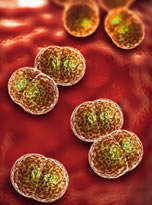Read and report vaccine reactions, harassment and failures.
Who is Most at Risk for Contracting Meningococcal Disease?

Babies and young children under the age of one are at highest risk for developing invasive meningococcal disease, along with adolescents and young adults between the ages of 16 and 23 years of age, and older adults.
There are certain environmental and biological factors that increase a person’s risk of developing meningococcal disease. Environmental factors include smoking or living with a smoker, alcohol consumption, and living in crowded environments that may include prisons or military settings. Low socioeconomic status and minority ethnicity have also been linked to higher rates of meningococcal disease. Biological factors such as functional or anatomic asplenia, genetic polymorphism, and innate immune system deficiencies as well as chronic immune system disorders such as lupus or HIV/AIDS or even a recent respiratory illness may also increase a person’s risk of developing meningococcal disease. Additionally, men who have sex with other men, including HIV-infected men, may also be at a greater risk for the disease.
In 2020, nearly 5 percent of meningococcal cases occurred in person living with HIV disease.
Individuals who take eculizumab (Soliris®), a medication often prescribed for paroxysmal nocturnal hemoglobinuria (PNH) or atypical hemolytic uremic syndrome, are also at a higher risk for the disease.
Having a low level of serum bactericidal antibody (SBA) has also been associated with a higher risk of meningococcal disease. Due to genetic and biological factors, a small minority of the population are unable to develop protective antibodies against meningococcal bacteria and have up to a 7,000 times greater risk of developing invasive meningococcal disease in their lifetime.
In 2010, the Imperial College London and the Genome Institute of Singapore conducted a large-scale study on invasive meningococcal disease and the complications of meningitis and meningococcemia (septicemia) resulting from the disease. By comparing the genetic make-up of 1,500 meningococcal meningitis sufferers to nearly 5,000 healthy controls, researchers found that individuals who developed meningitis from meningococcal disease had genetic markers in a number of genes that prevented them from fighting the meningococcal bacteria. Genetic variations in Factor H and Factor H-related proteins, proteins which regulate part of the immune system by recognizing and killing bacteria, were found to play a role in the risk of meningococcal disease. From their findings, researchers concluded that genetic factors likely play a significant role in the development of invasive meningococcal disease.
NVIC “Quick Facts” is not a substitute for becoming fully informed about Meningococcal disease, meningitis and the Meningococcal vaccine. NVIC recommends consumers read the more complete information following the "Quick Facts", as well as the vaccine manufacturer product information inserts, and speak with one or more trusted health care professionals before making a vaccination decision for yourself or your child.



